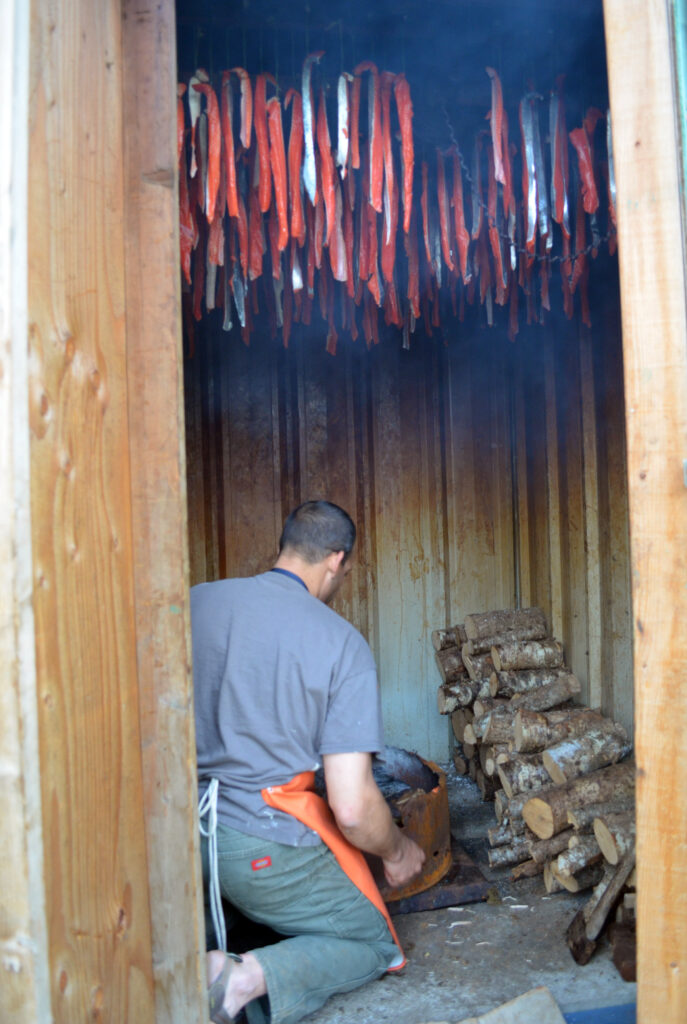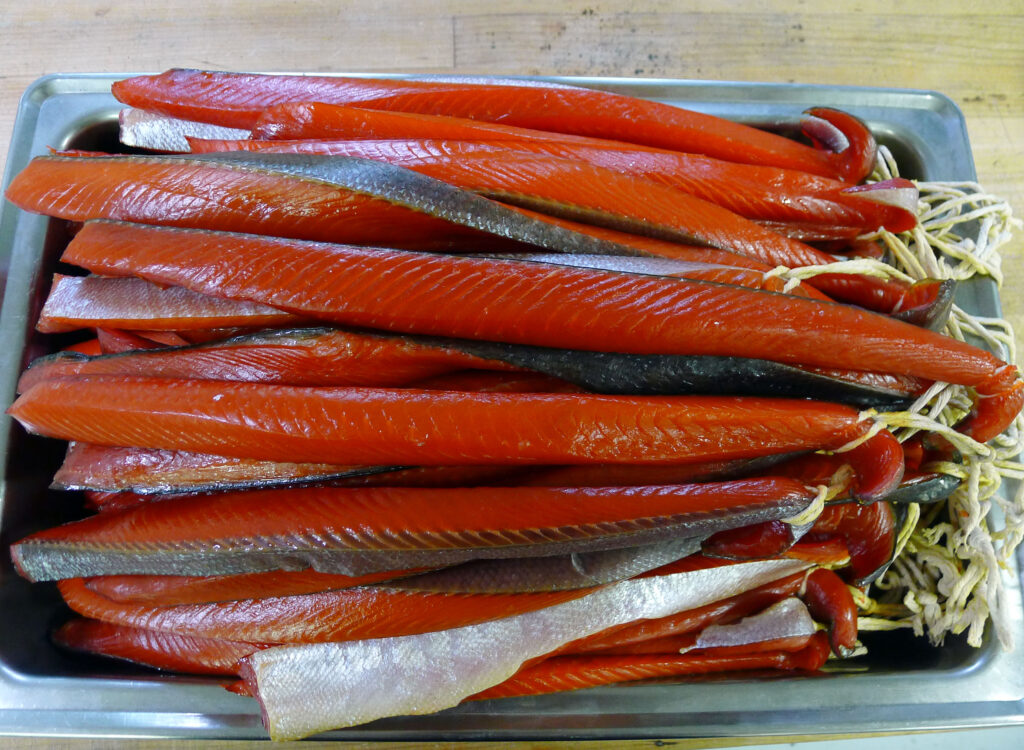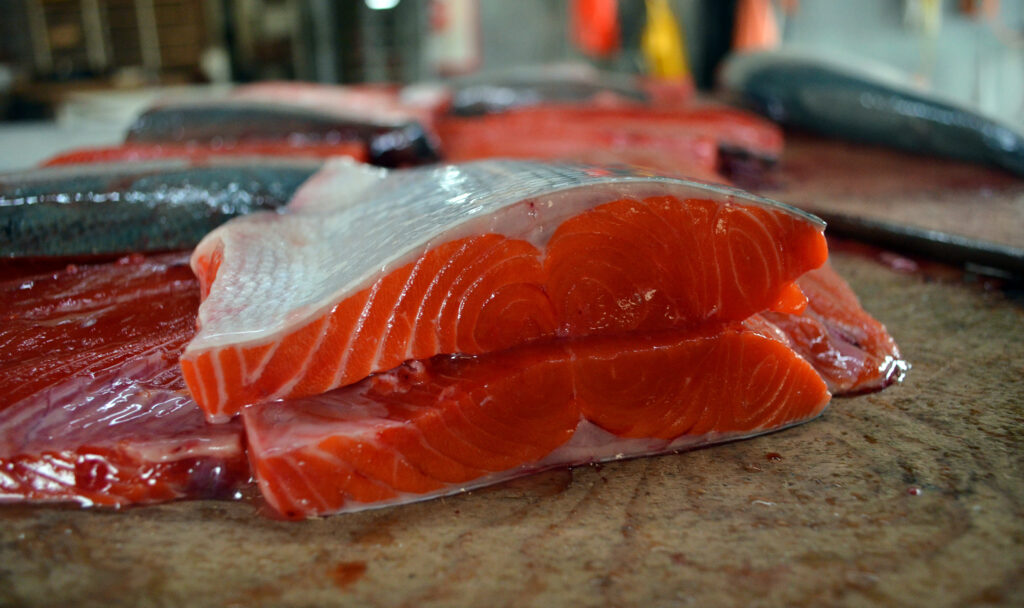When Alaskans put away some of the salmon they catch in the summer, it helps them get through the long winters in the Last Frontier. A healthy winter pack that they catch, process, and store keeps them fed with some of the best protein on the planet. Also, it is a reminder of the wondrous bounty that Alaskan summers offer up.
I was working as a fishing guide in Cordova, Alaska. My friend Carlos and I had a rare day off together, so we smoked salmon in the afternoon. A friend gave him a dozen Copper River Sockeye, and he was putting them away for the winter. I was happy to help.
Salmon is one of the most delicious and nutritious types of fish out there It’s loaded with protein, healthy fats like omega-3s, and important micronutrients. However, fresh salmon tends to have a short shelf life and goes bad quickly if not stored properly.
Luckily there are several methods you can use to extend the shelf life of salmon so you can enjoy it year-round. In this comprehensive guide I’ll walk you through the most popular techniques for preserving salmon at home.
Overview of Preserving Salmon
Here are some of the most common ways to preserve salmon:
-
Freezing Freezing is the simplest way to preserve salmon long-term It stops bacteria growth and prevents spoilage Salmon can be frozen raw or cooked.
-
Canning: Canning involves cooking salmon and sealing it in air-tight jars. The high heat kills bacteria, and the airtight seal prevents recontamination. Canned salmon lasts 1-2 years stored in a cool, dark place.
-
Curing: Curing involves coating salmon fillets with a salt, sugar, and spice mixture. This takes out the water, makes it impossible for bacteria to live there, and makes the salmon more “cured.” Gravlax and smoked salmon are two popular cured salmon products.
-
Smoking: Smoking cooks the salmon with smoke at low temperatures. The smoke kills bacteria while adding flavor. Smoked salmon lasts 2-3 weeks refrigerated.
-
Drying: Dehydrating or air-drying salmon jerky removes moisture so bacteria can’t grow. Salmon jerky can last up to a year stored properly.
-
If you pickle salmon in an acidic liquid like vinegar or lemon juice, the bacteria won’t be able to grow. Pickled salmon keeps in the fridge for 2-3 months.
Now let’s look at each preservation method in more detail, along with tips, tricks, and step-by-step instructions to preserve your salmon.
Freezing Salmon
Freezing is hands-down the easiest way to preserve fresh salmon. It stops bacteria growth and keeps the salmon safe to eat for 9-12 months.
Here are some tips for freezing salmon:
-
Freeze salmon as soon as possible after catching or buying. The fresher it is, the better the texture will hold up.
-
Clean, gut, and fillet salmon before freezing. Discard guts, bones, head and tail.
-
Pat salmon dry with paper towels and remove any blood spots or scales.
-
Cut salmon into portion sizes you plan to use like fillets, steaks, or chunks.
-
Wrap each portion in freezer-safe plastic wrap, parchment paper, or aluminum foil. Make sure it’s wrapped airtight with no air pockets.
-
Place wrapped salmon flat in a single layer in a resealable plastic freezer bag. Squeeze out excess air and seal.
-
Label bag with type of salmon and freeze date.
-
Freeze at 0°F or below. Use freezer bags, containers, or heavy duty aluminum foil to prevent freezer burn.
-
Once frozen, salmon can be stacked or consolidated to save space.
-
Thaw frozen salmon overnight in the fridge. Do not thaw at room temp.
-
Use thawed salmon within 3 days. Do not refreeze thawed salmon.
Freezing salmon is that easy! Just remember to wrap it airtight, label it, and eat within 3 days after thawing.
Canning Salmon
Canning is a preservation method that kills bacteria with heat and seals food in airtight jars. Canned salmon can be eaten straight from the jar or incorporated into recipes. Follow these steps:
Step 1: Get Mason Jars and Lids
You’ll need Mason jars, new lids, and screw bands that fit your jars. The jars and lids must be thoroughly cleaned and sterilized before canning.
Step 2: Cut Salmon into Jar-Sized Pieces
Remove bones, skin, fins, and bellies from salmon and cut fish into jar-sized portions.
Step 3: Pack Jars Tightly
Put salmon pieces into jars, leaving 1-inch of headspace. If using liquid like oil, broth, or tomato sauce, leave 1⁄2-inch space. Pack tightly to remove air pockets. Wipe jar rims with a clean, damp towel.
Step 4: Apply Lids and Bands
Put new lids on jars and screw bands on fingertip tight. Do not overtighten bands.
Step 5: Process Jars in Boiling Water Bath
Place jars on a rack in a large pot filled with enough water to cover jars by 1-2 inches. Bring water to a boil and process for recommended time based on jar size:
- Half pints or pints – 75 minutes
- Quarts – 90 minutes
Step 6: Cool and Store
Remove jars and let cool undisturbed for 12-24 hours. Check lids have sealed and remove bands. Wipe down jars and label with content and date. Store in a cool, dark place up to 2 years. Refrigerate after opening.
Canning salmon enables long term storage at room temperature. Just be sure to follow proper sanitizing procedures exactly. Botulism and other dangerous bacteria can grow if jars are not processed and sealed correctly.
Curing Salmon with Gravlax and Smoked Salmon
Curing gives salmon a unique flavor and firmer texture that prolongs shelf life. Popular cured salmon products are gravlax and smoked salmon.
How to Make Gravlax
Gravlax originated in Scandinavia. It’s salmon cured in a salt, sugar, and dill mixture. Follow these steps:
Step 1: Mix equal parts kosher salt and granulated sugar. Coat salmon fillet thoroughly on all sides.
Step 2: Sandwich salmon between layers of cheesecloth. Add more salt-sugar mix on top.
Step 3: Weigh down salmon and refrigerate for 24-48 hours, flipping halfway through.
Step 4: Rinse gravlax, pat dry, and slice thinly on the bias.
Refrigerate leftover gravlax up to 5 days. The salt and sugar cure gives it a shelf life of 1-2 weeks.
How to Make Smoked Salmon
Smoked salmon is cured with salt and sugar first, then hot or cold smoked. Follow these basic steps:
Step 1: Mix 1 cup salt with 1/2 cup brown sugar. Coat salmon fillet on all sides.
Step 2: Refrigerate salmon for 12-24 hours to cure. Rinse off cure mix.
Step 3: Smoke salmon for 6-12 hours at low temp (100-150°F) using preferred wood chips.
Step 4: Slice smoked salmon thinly and eat within 2 weeks. Keep refrigerated.
Gravlax and smoked salmon last longer than fresh salmon thanks to the salt, sugar, and/or smoke used to cure them.
How to Make Salmon Jerky
Dehydrating salmon into jerky removes moisture so bacteria can’t grow. Here’s a simple salmon jerky recipe:
Ingredients:
- 2 lbs salmon fillet, skin removed
- 1/4 cup soy sauce
- 2 tbsp brown sugar
- 1 tbsp honey
- 1 tsp black pepper
- 1 tsp garlic powder
- 1 tsp onion powder
- 1 tsp red pepper flakes
Instructions:
-
Cut salmon into 1/4 inch thick strips with the grain.
-
Whisk together marinade ingredients. Pour over salmon and marinate 30 mins – 1 hour.
-
Drain and pat dry salmon strips with a paper towel.
-
Arrange strips in a single layer on dehydrator trays. Dehydrate at 145°F for 6-8 hours until dried.
-
Pat off any beads of oil. Store jerky in an airtight container up to 1 year.
Salmon jerky can also be made in the oven at 170°F with the door propped open slightly. Drying removes moisture so salmon jerky can be stored and eaten longer without spoiling.
How to Pickle Salmon
Pickling salmon in an acidic brine extends shelf life. You can quick-pickle salmon in just 20 minutes or fridge-pickle it for long term storage.
For quick-pickling:
- Cut salmon into 1/2 inch cubes.
- Heat 1 cup vinegar, 1 cup water, 1 tbsp salt, and any spices to a boil.
- Remove from heat and pour over salmon cubes in a container.
- Refrigerate 1 hour then serve.
For fridge-pickling:
- Cut salmon into strips or cubes.
- In a jar, layer salmon and sliced onions with pickling spice mix.
- In a saucepan, bring vinegar, water, salt, and sugar to a boil.
- Pour hot brine over salmon, making sure it’s submerged.
- Refrigerate 1-2 days before eating. Keeps 2-3 months refrigerated.
The vinegar acidity inhibits bacterial growth while the salt

The Long, Light Salmon Smoke
Carlos came back a day later and built a small fire in the smokehouse. This is where Carlos’ experience showed in stride. He taught me about that excellent line where there is a steady smoke but not enough flame to make the area hot enough to cook the strips. After all, the eventual bath in the pressure canner would take care of the cooking portion. A light haze of smoke filled the smokehouse. The Alder was dry-aged and sourced from a grove down the road.

After one night and a day of tending the fire in the smokehouse, it was time. Carlos called me up to review our work. We opened the smokehouse door and the strips of Red Salmon appeared before us, perfectly smoked. Not a minute too soon or too late. We pulled them all down and took them for a road trip to my Lodge. Where we had a big kitchen to work in. And had prepped enough jars for a couple loads of canning.

The Salmon Bounty of an Alaskan Summer
In Alaska, summer is the season of harvesting. Alaskan residents pick up their subsistence permits and head out to their local rivers and marine areas to bring home enough salmon to last them through the entire year. Many families make a long week of this. And boy, do they know how to catch. It doesn’t hurt that most of the state has phenomenal returns of Reds (Sockeye), Silvers (Coho) and Kings (Chinook). Hard work paves the way to a pantry full of preserved salmon. From the planning stages all the way until you pull those jars of Red Gold from the pressure canner. Since my Alaska days, I’ve picked up a few good books that bring back great memories and do a great job of sharing the heritage and process that Alaskans go through to put up smoked salmon, Salmon Sisters and Putting Up Fish on the Kenai, both great reads.

How to Preserve Salmon | Brined, Smoked & Canned
FAQ
How do you preserve fresh salmon?
What is the method of preserving salmon?
How do you store salmon long term?
Can I freeze raw salmon?
How do you keep salmon fresh and safe to eat?
Properly storing salmon is crucial to keeping it fresh and safe to eat. By buying fresh salmon, keeping it cold, freezing it, thawing it safely, and cooking it properly, you can ensure that your salmon is delicious and healthy.
Is fresh salmon safe to eat?
Yes, salmon is a source of omega 3, the fatty acid is responsible for acting in the prevention of cardiovascular diseases, making the heart strong and healthy. Just be careful to analyze the supplier to make sure it doesn’t have any contamination.
How do you store fresh salmon?
To store fresh salmon, wrap it tightly in plastic or foil and place it in the coldest part of your fridge. Frozen salmon should be stored in a freezer bag with minimal air. Cooked salmon should be kept in an airtight container in the fridge. Always remember to consume fresh and cooked salmon within 1-2 and 3-4 days, respectively.
How long can you keep cured salmon?
It depends on how much you cure the salmon. I would not keep lightly cured salmon (24 hours) beyond 36 hours at most (just to be safe). Medium cured salmon (36 – 48 hour cure) for 2 days to be safe, but 3 should be fine. Hard cured salmon (3 day cure) can be kept for 5 days.
